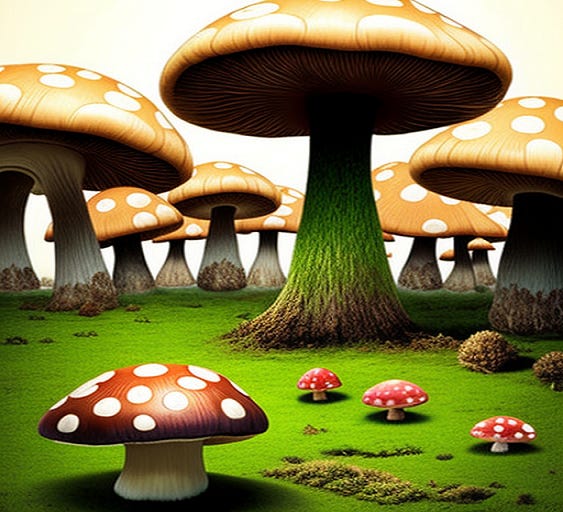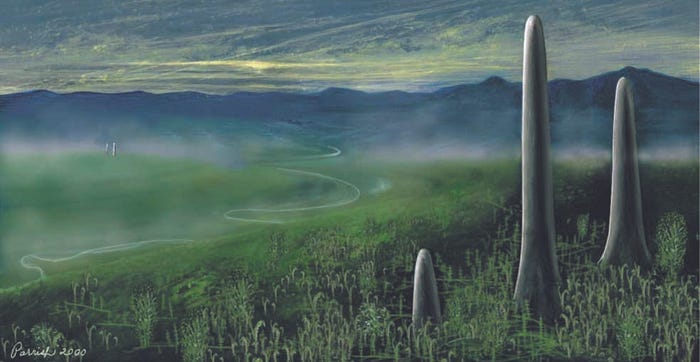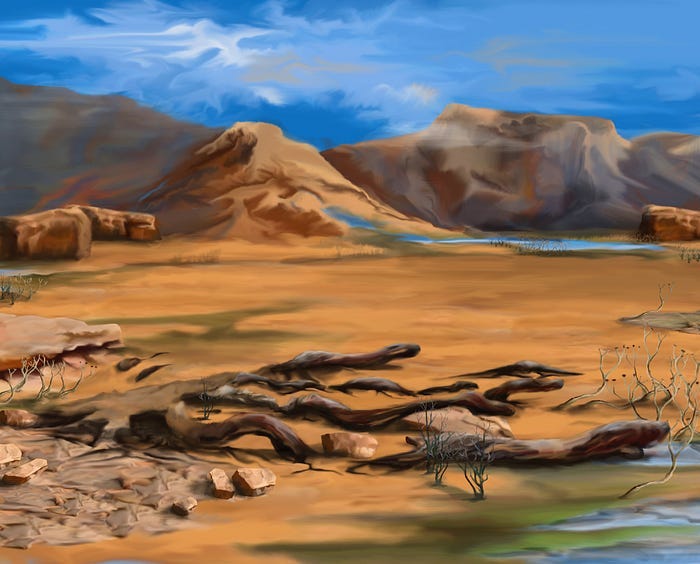Before Trees Ruled, The Earth Was Covered By Giant Fungi
They were possibly twenty-four feet tall and three feet wide
1

Sometimes it’s hard to visually imagine how much things change over time. The building my family business uses as a warehouse was once a hayloft, but it’s hard to picture. It sits dead in the middle of a city, surrounded by streets and cars, with an elevated train only a few blocks away.
A hundred years equates to great change. Now, what happens if we magnify this by millions? I want you to picture the earth long before mammals and dinosaurs roamed its surface. How about even a time before trees owned the land?
It’s hard to comprehend. After all, they’re omnipresent; everywhere you look you’ll see some form of tree. But as weird as it sounds, sharks are older than trees. And at one time, trees were newbies — only growing a few feet tall — while another lifeform owned their position.
This is where it gets difficult, and where you really need your imagination. They were a giant fungus called Prototaxites. Forgive my picture above, but it is what I pictured when first hearing about the scientific studies: massive mushrooms. But the real Prototaxites were a bit different.
While they’re related to modern fungus, they didn’t look like something out of Super Mario World. In fact, they’re quite alien to us now. So, we need to do a little investigation to make the picture more understandable.
A Mystery For Over A Hundred Years
According to the University of Chicago Magazine, Prototaxites are thought to have lived from 430 to 350 million years ago. C. Kevin Boyce, a geophysicist at the college says at this time only insects and small plants inhabited the land.
So, Prototaxites we’re likely the largest living terrestrial organisms on the earth at this time. Although their fossils were only discovered in the mid-1800s. Since then, specimens have been found in Saudi Arabia, Australia, and Canada, among other locations. It’s believed they could reach heights of twenty-four feet with trunk structures about three feet wide.

Moreover, for the past hundred and fifty years, scientists have been arguing about what exactly they were. While originally classified as conifers, they were later thought to be a lichen or algae. Eventually most came to recognize them as fungus.
Boyce says the main problem with Prototaxites are “that when you look up close at the anatomy, its evocative of a lot of different things, but its diagnostic of nothing.” Their size is also difficult to comprehend. A twenty- foot algae, lichen, or fungus doesn’t make any sense to a modern mind.
However in 2007, Boyce figured out a way to examine the mystery organism with geochemistry. Although a fossil, its carbon isotopes could be analyzed. This would effectively show what things it ate by giving an idea of its metabolism.
He found “an insanely large isotopic range,” which was much larger than a plant, that’s limited by photosynthesis. So, this organism wasn’t making food, it was consuming organic matter from the earth. This is much more reminiscent of a fungus.
But while consensus leans heavily towards fungus, there’s still a good deal of debate on how it functioned — even whether it stood upright like a tree.
More Like Mega Rhizomorphs
“The morphological and anatomical similarities between the studied Prototaxites and modern rhizomorphs are striking.”
— Vivi Vajda, Larissa Cavalcante, Kristoffer Palmgren, Ashley Krüger, and Magnus Ivarsson. Prototaxites reinterpreted as mega-rhizomorphs, facilitating nutrient transport in early terrestrial ecosystems
In their 2022 scholarly article in The Canadian Journal of Microbiology, the research team above compared samples of Prototaxites from quarries in Germany and Canada versus fungus prevalent in our time. Each was studied with a series of modern powerful microscopes.
They found structures within the fossils looked very similar to modern rhizomorphs in some of the fungus they grew in the lab. If you’re not a fungus nerd — and seriously, why wouldn’t you be — a rhizomorph looks like a root structure in a plant.

These root-like appendages allow a fungus to transfer nutrients over a distance. Also, to feed on living matter. They can grow through soil, wood, or other living organisms.
The researchers explain both the fossils and modern fungus “consist of tubular structures of similar length and diameter, fused together into a tissue-like material.” Moreover, some microscopic images of rhizomorphs grown in their lab look a bit like tiny Prototaxites.

However, they do have one major point of contention: the research team doesn’t believe Prototaxites grew vertically. In their opinion, the fungus grew horizontally. And there is a bit of logic to back their idea.
First of all, no samples of them have been recorded standing vertically in the ground. They’re all laying down. Furthermore, it would be a better strategy for collecting nutrients if they were horizontal — especially in their environment. The researchers note:
“At that time, the population of living plants and accumulations of dead plant matter available for fungal decomposition was meagre comparable to our modern world.”

Laying vertically would enable the Prototaxites to spread over a longer distance to find nutrients and water. Once found, it could be transferred. So, width over height appears to give the fungus a better shot at thriving in this time period.
Although the majority favors the idea of a tree-like vertical organism due to their trunk structure.
Inevitably, looking back that far in time will tend to put some haze on the lens of clarity. But it does give us an image of our world long ago.
A Time When Our Earth Was Dominated By Fungus
While a hundred years may be long in our present time horizon, that’s a blip in the eye of the earth’s. In fact, our early planet would be totally alien to us today. Imagine traveling in a landscape without trees high above you.
Moreover, it would also be hard to reconcile massive fungus as a dominate lifeform — whether horizontal or vertical. Needless to say, it gives you something to think about each time you toss some mushrooms in your salad. Back then, you would have needed a much bigger bowl.
-Originally posted on Medium 9/21/23



How was there enough organic matter in the soil to support such large fungal organisms?